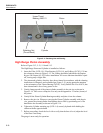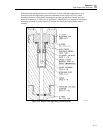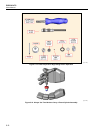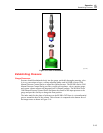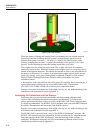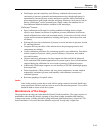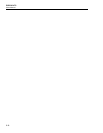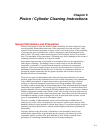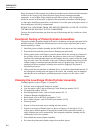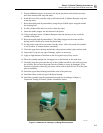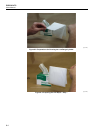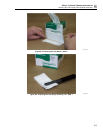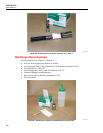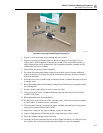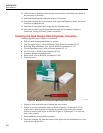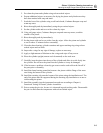
RUSKA 2470
Users Manual
6-2
Being forewarned of the hazards, the technician should wipe the bench and all instrument
surfaces in the vicinity of the Piston Pressure Gauge before starting disassembly
operations. A wad of Kim-Wipes slightly wetted with a solvent, such as high grade
alcohol or acetone will help pick up particles that invariably accumulate near the gauge.
A clean space should be prepared on a work bench. Cover this space with paper towels so
that cleaned parts will not be contaminated.
REMOVE ALL PRESSURE FROM THE PISTON PRESSURE GAUGE BY VENTING
THE PRESSURE HOUSING TO THE ATMOSPHERE.
Unscrew the knurled retaining cap from the top of the housing and lay it aside on a clean
Kim-Wipe.
Functional Testing of Piston/Cylinder Assemblies
The piston/cylinder assembly should be tested for cleanliness and proper operation before
and after each use. Perform the following steps to test for proper operation and to show
that the assembly is clean.
1. Install the piston/cylinder assembly into the DWG base and secure the retaining cap.
2. Pressure the base until the piston alone is floating near mid-stroke.
3. With a gentle stroke of the finger, rotate the piston while also causing it to bounce in
the cylinder. After a few strokes allow the piston to coast on its own. Although the
rotation of the mid and high ranges may be lengthy, the free rotation of the low range
may last only a brief few seconds. At any rate, all ranges should rotate freely with no
sudden changes in rotation speed and should coast to a gradual stop. The last bit of
rotation just before stopping is often the most useful in judging if the piston is
functioning correctly.
4. If the piston does not perform as indicated above, it should be cleaned and retested. If
the subsequent cleaning does not improve the results, the assembly may be damaged
and should not be used until a qualified inspection is made as to the source of the
failure.
Cleaning the Low Range Piston/Cylinder Assembly
Cleaning supplies (refer to Figure 6-1) consist of:
• Solvent, such as high grade alcohol or acetone
• Low-lint paper wipers, such as Kimberly Clark, Kimwipes number 34155
• Cleaning tool number 2460-56
• Wooden applicator sticks, such as Puritan number 807-12
• Cashmere Bouquet brand hand soap
• Bottle brush, such as RUSKA part number 7-682
• Size 0 rubber stopper, such as RUSKA part number 81-536
• Warm tap water
1. Prepare a clean work area near a running tap water source.
2. Prepare several sets of folded wipers as shown in Figures 6-2 through 6-4. Two
wipers can be folded together for wiping the outside of the piston and cylinder. A
single folded wiper can be inserted into, then wrapped around the cleaning tool for
cleaning the bore of the cylinder.
3. Disassemble the piston/cylinder assembly.
4. Pre-clean the piston and cylinder using solvent soaked wipers.



